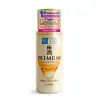What's inside
What's inside
 Key Ingredients
Key Ingredients

 Benefits
Benefits

 Concerns
Concerns

 Ingredients Side-by-side
Ingredients Side-by-side

Water
Skin ConditioningGlycerin
HumectantSqualane
EmollientJojoba Oil/Macadamia Seed Oil Esters
Skin ConditioningIsosorbide Dicaprylate
Skin ConditioningPolyglyceryl-6 Distearate
EmulsifyingNiacinamide
SmoothingCeramide NP
Skin ConditioningCeramide Ns
Skin ConditioningCeramide AP
Skin ConditioningCeramide EOP
Skin ConditioningCeramide Eos
Skin ConditioningCholesterol
EmollientSodium Hyaluronate
HumectantXylitylglucoside
HumectantAnhydroxylitol
HumectantBetaine
HumectantXylitol
HumectantBeta-Glucan
Skin ConditioningHydrolyzed Jojoba Esters
Skin ConditioningJojoba Esters
EmollientGlucose
HumectantTocopheryl Acetate
AntioxidantTocopherol
AntioxidantAscorbyl Palmitate
AntioxidantSqualene
EmollientPhytosteryl Macadamiate
Skin ConditioningPhytosterols
Skin ConditioningCaprooyl Phytosphingosine
Skin ConditioningCaprooyl Sphingosine
Skin ConditioningSaccharide Isomerate
HumectantPolyglyceryl-3 Beeswax
EmulsifyingGlyceryl Caprylate
EmollientSodium Anisate
AntimicrobialEthylhexylglycerin
Skin ConditioningCetyl Alcohol
EmollientBehenic Acid
CleansingSodium Carrageenan
Emulsion StabilisingSea Salt
AbrasiveXanthan Gum
EmulsifyingAlgin
MaskingCarbomer
Emulsion StabilisingPolyacrylate Crosspolymer-11
Emulsion StabilisingCeteareth-25
CleansingSodium Citrate
BufferingSodium Hydroxide
BufferingCitric Acid
BufferingPhenoxyethanol
PreservativeBenzoic Acid
MaskingSorbic Acid
PreservativeWater, Glycerin, Squalane, Jojoba Oil/Macadamia Seed Oil Esters, Isosorbide Dicaprylate, Polyglyceryl-6 Distearate, Niacinamide, Ceramide NP, Ceramide Ns, Ceramide AP, Ceramide EOP, Ceramide Eos, Cholesterol, Sodium Hyaluronate, Xylitylglucoside, Anhydroxylitol, Betaine, Xylitol, Beta-Glucan, Hydrolyzed Jojoba Esters, Jojoba Esters, Glucose, Tocopheryl Acetate, Tocopherol, Ascorbyl Palmitate, Squalene, Phytosteryl Macadamiate, Phytosterols, Caprooyl Phytosphingosine, Caprooyl Sphingosine, Saccharide Isomerate, Polyglyceryl-3 Beeswax, Glyceryl Caprylate, Sodium Anisate, Ethylhexylglycerin, Cetyl Alcohol, Behenic Acid, Sodium Carrageenan, Sea Salt, Xanthan Gum, Algin, Carbomer, Polyacrylate Crosspolymer-11, Ceteareth-25, Sodium Citrate, Sodium Hydroxide, Citric Acid, Phenoxyethanol, Benzoic Acid, Sorbic Acid
Water
Skin ConditioningGlycerin
HumectantDipropylene Glycol
HumectantParaffinum Liquidum
EmollientDimethicone
EmollientCetyl Alcohol
EmollientTriethylhexanoin
MaskingHydrogenated Poly(C6-12 Olefin)
Skin ConditioningPalmitic Acid
EmollientCetyl Phosphate
EmulsifyingArginine
MaskingPhenoxyethanol
PreservativeSodium Hyaluronate
HumectantCarbomer
Emulsion StabilisingDisodium EDTA
Hydroxyethylcellulose
Emulsion StabilisingAllantoin
Skin ConditioningButylene Glycol
HumectantHydrolyzed Hyaluronic Acid
HumectantLactococcus/Hyaluronic Acid Ferment Filtrate
Aphanothece Sacrum Exopolysaccharides
AbsorbentHydroxypropyltrimonium Hyaluronate
Hydrolyzed Sodium Hyaluronate
Skin ConditioningSodium Acetylated Hyaluronate
HumectantSodium Hyaluronate Crosspolymer
HumectantPentylene Glycol
Skin ConditioningWater, Glycerin, Dipropylene Glycol, Paraffinum Liquidum, Dimethicone, Cetyl Alcohol, Triethylhexanoin, Hydrogenated Poly(C6-12 Olefin), Palmitic Acid, Cetyl Phosphate, Arginine, Phenoxyethanol, Sodium Hyaluronate, Carbomer, Disodium EDTA, Hydroxyethylcellulose, Allantoin, Butylene Glycol, Hydrolyzed Hyaluronic Acid, Lactococcus/Hyaluronic Acid Ferment Filtrate, Aphanothece Sacrum Exopolysaccharides, Hydroxypropyltrimonium Hyaluronate, Hydrolyzed Sodium Hyaluronate, Sodium Acetylated Hyaluronate, Sodium Hyaluronate Crosspolymer, Pentylene Glycol
 Reviews
Reviews

Ingredients Explained
These ingredients are found in both products.
Ingredients higher up in an ingredient list are typically present in a larger amount.
Carbomer is a polymer of acrylic acid. Its main role is to create a gel consistency.
A high amount of carbomer can cause pilling or balling up of products. Don't worry, most products contain 1% or less of carbomer.
Cetyl Alcohol is a fatty alcohol. Fatty Alcohols are most often used as an emollient or to thicken a product.
Its main roles are:
Though it has "alcohol" in the name, it is not related to denatured alcohol or ethyl alcohol.
The FDA allows products labeled "alcohol-free" to have fatty alcohols.
Learn more about Cetyl AlcoholGlycerin is already naturally found in your skin. It helps moisturize and protect your skin.
A study from 2016 found glycerin to be more effective as a humectant than AHAs and hyaluronic acid.
As a humectant, it helps the skin stay hydrated by pulling moisture to your skin. The low molecular weight of glycerin allows it to pull moisture into the deeper layers of your skin.
Hydrated skin improves your skin barrier; Your skin barrier helps protect against irritants and bacteria.
Glycerin has also been found to have antimicrobial and antiviral properties. Due to these properties, glycerin is often used in wound and burn treatments.
In cosmetics, glycerin is usually derived from plants such as soybean or palm. However, it can also be sourced from animals, such as tallow or animal fat.
This ingredient is organic, colorless, odorless, and non-toxic.
Glycerin is the name for this ingredient in American English. British English uses Glycerol/Glycerine.
Learn more about GlycerinPhenoxyethanol is a preservative that has germicide, antimicrobial, and aromatic properties. Studies show that phenoxyethanol can prevent microbial growth. By itself, it has a scent that is similar to that of a rose.
It's often used in formulations along with Caprylyl Glycol to preserve the shelf life of products.
Sodium Hyaluronate is hyaluronic acid's salt form. It is commonly derived from the sodium salt of hyaluronic acid.
Like hyaluronic acid, it is great at holding water and acts as a humectant. This makes it a great skin hydrating ingredient.
Sodium Hyaluronate is naturally occurring in our bodies and is mostly found in eye fluid and joints.
These are some other common types of Hyaluronic Acid:
Learn more about Sodium HyaluronateWater. It's the most common cosmetic ingredient of all. You'll usually see it at the top of ingredient lists, meaning that it makes up the largest part of the product.
So why is it so popular? Water most often acts as a solvent - this means that it helps dissolve other ingredients into the formulation.
You'll also recognize water as that liquid we all need to stay alive. If you see this, drink a glass of water. Stay hydrated!
Learn more about Water